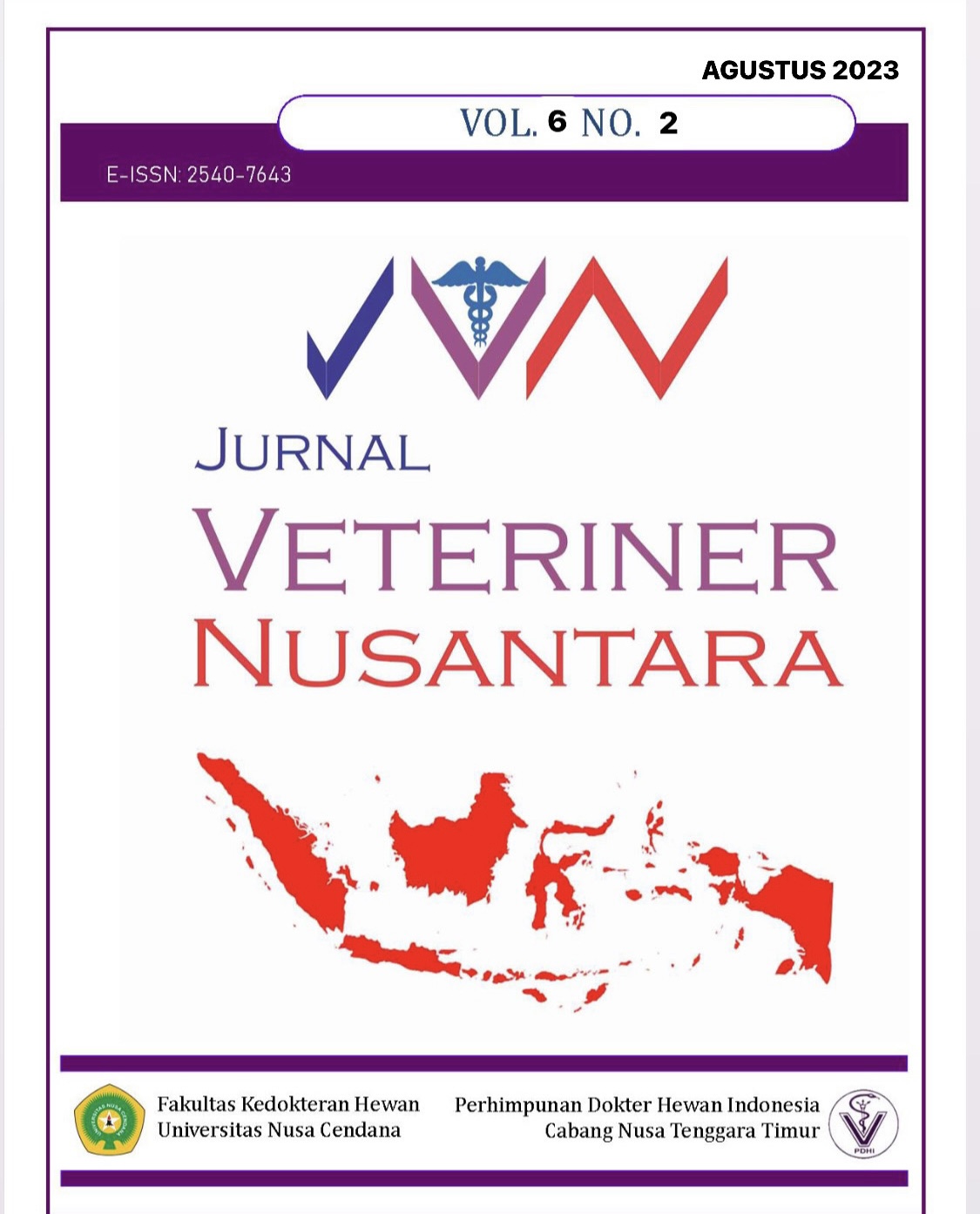Deteksi Escherichia coli Resisten Antibiotik pada Sumber Air dari Lingkungan Peternakan Unggas di Kecamatan Kelapa Lima Kota Kupang”
Abstract
Clean water is water that can be used for daily purposes whose quality meets health requirements and can be drunk if it has been cooked. The source of origin of the spread of resistant bacteria in addition to human and environmental origin has been reported to also come from animal husbandry. The presence of antibiotic-resistant bacteria such as Escherichia coli on farms is a threat to the health of farm animals and humans around the farm area. This study
aims to obtain information about the percentage of E. coli and the incidence of antibiotic resistance in E. coli bacteria isolated from water sources in the poultry farming environment in Kelapa Lima District, Kupang City. A total of 30 water source samples were taken by purposive sampling method, out of 30 samples 16 positive samples of E. coli were found. Samples are tested to obtain E. coli isolates supported by identification test examinations with biochemical tests and subsequently tested their sensitivity patterns to antibiots. The study was conducted by the Kirby-Bauer method. The type of antibiotic used in this study is based on the type of antibiotic in EFSA (2012) used in the monitoring of Resistant Antimicrobials (AMR) for Salmonella spp and E. coli through food. This guide suggests using a class of antibiotics commonly used in the treatment of bacterial infections in animals as well as humans. The interpretation of the results of this sensitivity test refers to the Clinical and Laboratory Standards Institute (CLSI 2012). The results of this study showed that as much as 53.3% (16/30 samples) of the water population in the poultry farming environment in Kelapa Lima District, Kupang City contained E. coli and obtained a percentage of E. coli that was resistant to tetracycline antibiotics, which was 6.25% (1/16 sample).
Downloads
References
Bakteri Vibrio Cholerae Terhadap
Antibiotik Ciprofloxacin dan Tetracycline.
Journal Health and Science. 6(1): 73-78.
Agustin, A. L. D., Ningtyas, N. S. I. I., & Tirtasari,
K. (2022). Resistensi Antibiotik Terhadap
Escherichia coli yang Diisolasi dari Ayam
Layer di Desa Sesaot Kabupaten Lombok
Barat. Media Kedokteran Hewan, 33 (2): 87-
95.
Allen, M. E. (2005). MacConkey agar plates
protocols. American society for
microbiology, 1-4.
Arifin, IN. (2013). Analisis Mikrobiologi pada
Makanan. [SKRIPSI]. Program Studi
Teknologi Hasil Pertanian Fakultas
Pertanian Universitas Sebelas Maret,
Surakarta.
Baehaqi, Mif, Sunardi, Akhlan, Riksma, N. Ridalti,
Heryati, Euis. (2015). Psikiatri: Konsep
Dasar dan Gangguan-Gangguan. Bandung:
PT. Refika Aditama
Clinical Laboratory Standards Institute. (2012).
Performance Standards for Antimicrobial
Disk Susceptibility Tests.22th ed.CLSI 2012
document M100- S22 Vol.32
No.3.USA:Clinical Laboratory Standards
Institute, Wayne,PA. 45-48.
Downes, F. P. dan K. Ito. 2001. Compendium of
Methods For the Microbiological
Examination of Food, 4th ed. APHA.
Washington D.C.
Eaton A. D., L. S. Clesceri, dan A. W. Greenberg.
2005. Standard Methods for the
Examination of Water and Wastewater, 21st
ed. APHA. Washington D.C.
[FAO] Food and Agriculture Organization. (2018).
Antimicrobial Resistance in the
Environment. [Internet]. [diunduh 2018 Sept
8]. Tersedia pada: http://www.fao.org/3/
BU656en/bu656en.pdf
Hamida, F., Aliya, L. S., Syafriana, V., & Pratiwi,
D. (2019). Escherichia Coli Resisten
Antibiotik Asal Air Keran Di Kampus Istn.
Jurnal Kesehatan, 12(1): 63–72.
Handayani, R. S., S. Siahaan, & M. J. Herman.
(2017). Resistensi Antimikroba dan
Penerapan Kebijakan Pengendalian di
Rumah Sakit di Indonesia. Jurnal penelitian
dan pengembangan pelayanan kesehatan.
1:131–140.
Hapsari, D. (2015). Kajian Kualitas Air Sumur Gali
dan Perilaku Masyarakat di Sekitar Pabrik
Semen Kelurahan Karangtalun Kecamatan
Cilacap Utara Kabupaten Cilacap. Jurnal
Sains dan Teknologi Lingkungan.1(7):01-17.
Hemraj, V., S. Diksha, dan G. Avneet. (2013). A
Review on Commonly Used Biochemical
Tests for Bacteria. Innovare Journal of Life
Science. 1(1): 1-7.
Ismail, Y. S., Yulvizar, C., & Putriani, P. (2017).
Isolasi, karakterisasi dan uji aktivitas
antimikroba bakteri asam laktat dari
fermentasi biji kakao (Theobroma cacao L.).
Jurnal Bioleuser, 1(2):45-53.
Jacoby, G.A. (2005). Mechanism of Resistance to
Quinolones. Oxford Journals: Clinical
Infectious Diseases. Massachusetts: Oxford
Journals, 41: S120-S126.
Januari, C., Sudarwanto, M. B., Purnawarman, T.
(2019). Resistensi Antibiotik pada
Escherichia coli yang Diisolasi dari Daging
Ayam pada Pasar Tradisional di Kota
Bogor. Jurnal veteriner maret, 20 (1): 125-
131.
Kallau, N., Wibawan, I. W. T., Lukman, D. W., &
Sudarwanto, M. B. (2019). Studi Pemetaan
Multidrug resistant (Mdr) Escherichia Coli
pada Peternakan Babi di Kota Kupang.
Jurnal Kajian Veteriner, 7(1): 70-90.
Author et al. 20xx
Vol.x No. y
13
Kemenkes RI. (2013). Riset Kesehatan Dasar.
Jakarta: Badan Penelitian dan
Pengembangan Kesehatan.
Kepel, L., Fatima Wali., dan Budiarso, F. (2015).
Uji Resistensi Bakteri Eschericia coli yang
Diisolasi dari Plak Gigi Terhadap Merkuri
dan Antibiotik Ciprofloxacin. Jurnal e-
Biomedik (eBm). 3(1).
Lumantouw SF, Febby EFK, Sendy BR, Marina
FOS. (2013). Isolasi dan identifikasi bakteri
yang toleran terhadap fungisida mankozeb
pada lahan pertanian tomat di DesaTempok,
KecamatanTompaso, Sulawesi Utara. Bios
Logos. 3(2):73-77.
Marshall, B. M., & Levy, S. B. (2011). Food animals
and antimicrobials: impacts on human
health. Clinical microbiology reviews, 24(4):
718-733.
Mudatsir, M. (2007). Faktor-faktor yang
Mempengaruhi Kehidupan Mikroba dalam
Air . Jurnal Kedokteran Syiah Kuala, 7(1):
23-30.
Noor, S. M., & Poeloengan, M. (2005). Pemakaian
antibiotik pada ternak dan dampaknya pada
kesehatan manusia. Prosiding lokakarya
nasional keamanan pangan produk
peternakan. Bogor (ID): Puslitbang
Peternakan, 18-22.
Nurmala, Virgianghi, ISN, Andriani, & Liana, D.F.
(2015). Resistensi dan Sensitivitas Bakteri
terhadap Antibiotik di RSU dr. Soedarso
Pontianak Tahun 2011-2013. eJKI, 3(1).
Pakpahan, R. S., Picauly, I., & Mahayasa, I. N. W.
(2015). Cemaran mikroba Escherichia coli
dan total bakteri koliform pada air minum isi
ulang. Kesmas: Jurnal Kesehatan
Masyarakat Nasional (National Public
Health Journal), 9(4): 300-307.
Panagan, A. T., & Syarif, N. (2009). Uji daya
hambat asap cair hasil pirolisis kayu
pelawan (Tristania abavata) terhadap bakteri
Escherichia coli. Jurnal Penelitian Sains,
Edisi Khusus 09. 12(6): 30-32.
Peraturan Menteri Kesehatan R.I, No.
416/Menkes/Per/IX/1990 tentang syarat-
syarat dan pengawasan kualitas air, Jakarta.
Permenkes. (2015). Peraturan Menteri Kesehatan
Republik Indonesia Nomor 8 Tahun 2015
Tentang Program Pengendalian Resistensi
Antimikroba di Rumah Sakit.
Peterson, L. R. (2005). Squeezing TheAntibiotic
Balloon: The Impact of Antimicrobial
Classes On Emerging Resistance. European
Society of Clinical Microbiology and
Infectious Diseases. The Feinberg School of
Medicine, North Western University, USA.
11: 4-16
Putri, A. L., & Kusdiyantini, E. (2018). Isolasi dan
identifikasi bakteri asam laktat dari pangan
fermentasi berbasis ikan (Inasua) yang
diperjualbelikan di Maluku-Indonesia.
Jurnal Biologi Tropika, 1(2): 6-12
Rahayu, S. A., & Gumilar, M. M. H. (2017). Uji
cemaran air minum masyarakat sekitar
Margahayu Raya Bandung dengan
identifikasi bakteri Escherichia coli.
Indonesian journal of pharmaceutical
science and technology, 4(2): 50-56.
Raini, M. (2016). Antibiotik Golongan
Fluorokuinolon: Manfaat dan Kerugian.
National Institute of Health Research and
Development, Indonesian Ministry of
Health. 26(3): 163-174.
Rosyidi A, Sriasih M, Sukartajaya IM. (2008).
Deteksi Escherichia Coli Sumber Ayam
Kampung dan Resistensinya Terhadap
Berbagai Antibiotik. Maduranch: Jurnal
Ilmu Peternakan, 3(1): 17-22.
Samy, A. A., Mansour, A. S., Khalaf, D. D., &
Khairy, E. A. (2022). Development of
multidrug-resistant Escherichia coli in some
Egyptian veterinary farms. Veterinary
World, 15(2): 488-495.
Setiabudy, 2016 : Setiabudy, R., & Gunawan, S.G.,
(2016). Farmakologi dan Terapi, hal. 725,
FKUI, Jakarta.
Copyright (c) 2023 Annisah Lis Dewi, Novalino H.G Kallau, Annytha I.R Detha

This work is licensed under a Creative Commons Attribution-ShareAlike 4.0 International License.

 Annisah Lis Dewi(1*)
Annisah Lis Dewi(1*)



 Visit Our G Scholar Profile
Visit Our G Scholar Profile




